Unmanned ground vehicle


An unmanned ground vehicle (UGV) is a vehicle that operates while in contact with the ground without an onboard human presence. UGVs can be used for many applications where it is inconvenient, dangerous, expensive, or impossible to use an onboard human operator. Typically, the vehicle has sensors to observe the environment, and autonomously controls its behavior or uses a remote human operator to control the vehicle via teleoperation.
The UGV is the land-based counterpart to unmanned aerial vehicles, unmanned underwater vehicles and unmanned surface vehicles. Unmanned robotics are being actively developed for both civilian and military use.
History[edit]
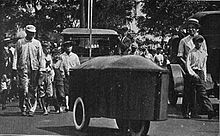
In 1904, Spanish engineer Leonardo Torres Quevedo was developing a radio-based control system he named Telekino. He chose to conduct an initial test in the form of a three-wheeled land vehicle (tricycle), which had an effective range of 20 to 30 meters, the first known example of an unmanned ground vehicle.[1][2]
The first prototypes of explosive robotic drones were Aubriot-Gabet 'land torpedoes' invented in France in 1915[3] and the Crocodile Schneider-Creusot, 20 examples were put into service with the 2nd French Army in July 1915.[4]
A working remote-controlled car was reported in the October 1921 issue of RCA's World Wide Wireless magazine. The car was controlled wirelessly via radio; it was thought the technology could be adapted to tanks.[5] In the 1930s, the USSR developed the Teletank, a small tank, armed with a machine gun. It was remotely controlled by radio from another tank. Teletanks operated in the Winter War (1939–1940) between Finland and the USSR and at the start of the German-Soviet War after Germany invaded the USSR in 1941. During World War II, the British developed a radio-controlled version of their Matilda II infantry tank in 1941. Known as "Black Prince", it would have been used for drawing the fire of concealed anti-tank guns, or for demolition missions. Due to the costs of converting the transmission system of the tank to Wilson-type gearboxes, an order for 60 tanks was cancelled.[6]
From 1942, the German Wehrmacht used the Goliath tracked mine for remote-controlled demolition work. The Goliath was a tracked vehicle carrying 60 kg of explosive charge, directed through a control cable. It modeled a miniature French tracked vehicle found after the German defeat of France in 1940. The combination of cost, low speed, reliance on a cable for control, and poor protection against weapons, meant that the Goliath was not considered a success.
The first major mobile robot development effort, named "Shakey", took place during the 1960s as a research study for the U.S. Defense Advanced Research Projects Agency (DARPA). Shakey was a wheeled platform that had a TV camera, sensors, and a computer to help guide its tasks of picking up wooden blocks and placing them in certain areas based on commands. DARPA subsequently developed a series of autonomous and semi-autonomous ground robots, often in conjunction with the U.S. Army. As part of the Strategic Computing Initiative of 1983-1993, DARPA c. 1985 demonstrated the Autonomous Land Vehicle,[7](ALV), the first UGV that could navigate completely autonomously on and off roads at useful speeds.[8][need quotation to verify]
On March 29 2024 as part of the Eastern Ukraine Campaign in the Ukraine War, a platoon of Russian UGV's equipped with AGS-17 automatic grenade launchers was deployed for an assault near the town of Berdychi in ukraine, marking the first ever use of UGV's for direct frontline assaults. [9]
Design[edit]
UGVs generally include: a vehicle platform, sensors, control systems, guidance interface, communication links, and systems integration features.[10]
Platform[edit]
The platform can be a car, truck, all-terrain vehicle, etc., and includes the locomotive apparatus, sensors, and power source. Tracks, wheels, and legs are common forms of locomotion. The platform may include an articulated body and may join with other units.[10][11] Power sources can be internal combustion engines, batteries, or hydrogen.[12]
Sensors[edit]
Sensors create a model of the environment, showing other vehicles, pedestrians, and obstacles. They also locate the vehicle on the navigation path. Sensors can include compasses, odometers, inclinometers, gyroscopes, cameras, laser and ultrasound rangefinders, GPS radios, and infrared technology.[10][13]
Control systems[edit]
Unmanned ground vehicles are generally considered Remote-Operated or Autonomous, although Supervisory Control is a combination of autonomous and remote operation.[14]
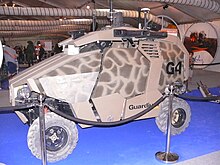
Remote operated[edit]
A remote-operated UGV is controlled by a human operator. The operator makes decisions based upon either direct visual observation or sensors such as cameras. A basic example of remote operation would be a remote-controlled toy car.
Examples:
- Autonomous Solutions[15]
- BTR-90 "Krymsk" APC[citation needed]
- Clearpath Robotics
- DOK-ING mine clearing, firefighting, and underground mining UGV's
- DRDO Daksh
- Foster-Miller TALON
- Frontline Robotics Teleoperated UGV (TUGV)[16]
- Gladiator Tactical Unmanned Ground Vehicle (used by the United States Marine Corps)
- G-NIUS Autonomous Unmanned Ground Vehicles (Israel Aerospace Industries/Elbit Systems joint venture) Guardium
- Goddard Remotely Operated Vehicle for Exploration and Research
- Uran-9
- iRobot PackBot
- MacroUSA Armadillo V2 Micro UGV (MUGV) and Scorpion SUGV
- Mesa Associates Tactical Integrated Light-Force Deployment Assembly (MATILDA)
- Nerekhta UGV, appeared at Zapad 2021 during Belarus-Russia exercise[17]
- Nova 5
- Remotec ANDROS F6A
- Ripsaw MS1
- Robowatch ASENDRO
- Unmanned Snatch Land Rover.[18]
- THeMIS used by the Royal Netherlands Army and developed by Milrem Robotics
- Unmanned ground vehicle Miloš used by Serbian Armed Forces
- Vecna Robotics Battlefield Extraction-Assist Robot (BEAR)
- VIPeR
Autonomous[edit]
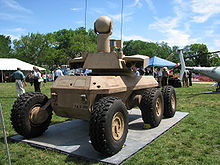
An autonomous UGV (AGV) is an autonomous robot that replaces the human controller with artificial intelligence technologies. The vehicle uses sensors to feed a model of the environment, which supports a control system that determines the next action. This eliminates the need for humans to watch over the vehicle.
An autonomous vehicle must have the ability to:
- Navigate based on maps that allow the vehicle to pick a route from origin to destination.
- Detect objects such as people and vehicles.
- Travel between waypoints without human assistance.
- Avoid harming people, property or itself, unless those are part of its mission.
A robot may also be able to learn autonomously. Autonomous learning includes the ability to:
- Gain capabilities.
- Adjust strategies based on the surroundings.
- Adapt to surroundings.
- Behave ethically in pursuit of mission goals.
Armed autonomous machines must distinguish between combatants and civilians. This is particularly true in conflicts where combatants intentionally disguise themselves as civilians to avoid detection. Even highly accurate but imperfect systems can pose unacceptable civilian losses.
Guidance interface[edit]
The interface between the machine and the human operator can include a joystick, autonomous software, or voice commands.[10]
Communication links[edit]
Communication between UGV and control station can be done via radio or fiber optics. It may include communication with other machines and robots.[10]
Systems integration[edit]
The various hardware and software elements must work together to produce desired results.[10][19]
Uses[edit]
A wide variety of UGVs are in use as of 2024. They are typically used to replace humans in hazardous situations, such as handling explosives and in bomb disabling vehicles, where additional strength or smaller size is needed, or where humans cannot safely go. Military applications include surveillance, reconnaissance, and target acquisition.[14] They are also used in industries such as agriculture, mining and construction.[20] UGVs are effective in naval operations, and have great importance for Marine Corps in combat; they can help in logistics operations on to the land and afloat.[21]
UGVs are also being developed for peacekeeping operations, ground surveillance, gatekeeper/checkpoint operations, urban street presence and to enhance police and military raids in urban settings. UGVs can "draw first fire" from insurgents—reducing military and police casualties.[22] Furthermore, UGVs are now being used in rescue and recovery mission and were first used to find survivors following 9/11 at Ground Zero.[23]
Space Applications[edit]
NASA's Mars Exploration Rover project included two UGVs, Spirit and Opportunity, that performed beyond the original design parameters. This is attributed to redundant systems, careful handling, and long-term interface decision-making.[10] Opportunity (rover) and its twin, Spirit (rover), six-wheeled, solar-powered ground vehicles, were launched in July 2003 and landed on opposite sides of Mars in January 2004. The Spirit rover operated nominally until it became trapped in deep sand in April 2009, lasting more than 20 times longer than expected.[24] Opportunity, by comparison, was operational for more than 14 years beyond its intended lifespan of three months. Curiosity (rover) landed on Mars in September 2011, and its original two-year mission has since been extended indefinitely.
Civilian and commercial applications[edit]
Multiple civilian applications of UGVs are being implemented to automatic processes in manufacturing and production environments.[25] They have also been developed as autonomous tour guides for the Carnegie Museum of Natural History and the Swiss National Exhibition Expo.[10]
Agriculture[edit]
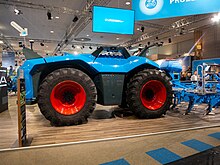
UGVs are one type of agricultural robot. Unmanned harvesting tractors can be operated around the clock making it possible to handle short windows for harvesting. UGVs are also used for spraying and thinning.[26] They can also be used to monitor the health of crops and livestock.[27]
Manufacturing[edit]
In the manufacturing environment, UGVs are used for transporting materials.[28] They are often automated and referred to as AGVs. Aerospace companies use these vehicles for precision positioning and transporting heavy, bulky pieces between manufacturing stations, which are less time-consuming than using large cranes and can keep people from engaging with dangerous areas.[29]
Mining[edit]
UGVs can be used to traverse and map mine tunnels.[30] Combining radar, laser, and visual sensors, UGVs are in development to map 3D rock surfaces in open pit mines.[31]
Supply chain[edit]
In the warehouse management system, UGVs have multiple uses from transferring goods with autonomous forklifts and conveyors to stock scanning and taking inventory.[32][33] Automated Guided Vehicles are extensively used in warehouses that deal with goods that are dangerous to humans (e.g. corrosive and flammable goods) or need special handling like passing through freezers.[34]
Emergency response[edit]
UGVs are used in many emergency situations including Urban search and rescue, fire fighting, and nuclear response.[23] Following the 2011 Fukushima Daiichi Nuclear Power Plant accident, UGVs were used in Japan for mapping and structural assessment in areas with too much radiation to warrant a human presence.[35]
Military applications[edit]

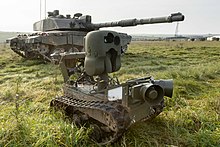
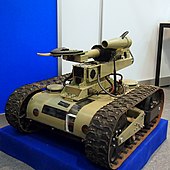
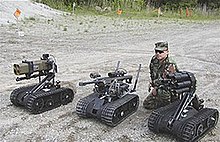
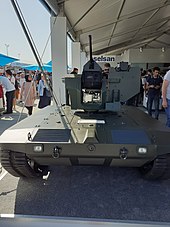
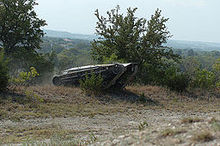
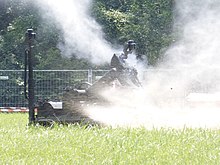
UGV use by the military has saved many lives. Applications include explosive ordnance disposal (EOD) such as landmines, loading heavy items, and repairing ground conditions under enemy fire.[14] The number of robots used in Iraq increased from 150 in 2004 to 5000 in 2005 and they disarmed over 1000 roadside bombs in Iraq at the end of 2005 (Carafano & Gudgel, 2007). By 2013, the U.S. Army had purchased 7,000 such machines and 750 had been destroyed.[36] The military is using UGV technology to develop robots outfitted with machine guns and grenade launchers that may replace soldiers.[37][38][17]
Examples[edit]
SARGE[edit]
SARGE is based on a 4-wheel drive all-terrain vehicle; the frame of the Yamaha Breeze. Currently, the objective is to provide each infantry battalion with up to eight SARGE units (Singer, 2009b). The SARGE robot is primarily used for remote surveillance; sent ahead of the infantry to investigate potential ambushes.
Multi-Utility Tactical Transport[edit]
Built by General Dynamics Land Systems, the Mult-Utility Tactical Transport ("MUTT") comes in 4-, 6- and 8-wheeled variants. It is currently being trialled by the US military.[39]
X-2[edit]
X-2 is medium-sized tracked UGV built by Digital Concepts Engineering. It is based on a previous autonomous robotic system designed for use in EOD, search and rescue (SAR), perimeter patrol, communications relay, mine detection and clearing, and as light weapons platform. It measures 1.31 m in length, weighs 300 kg and can reach speeds of 5 km/h. It will also traverse slopes up to 45' steep and cross deep mud. The vehicle is controlled using the Marionette system which is also used on Wheelbarrow EOD robots.[40][41]
The Warrior[edit]
A new model of the PackBot was also produced, known as the Warrior. It is over five times the size of a PackBot, can travel at speeds of up to 15 mph, and is the first variation of a PackBot capable of carrying a weapon (Singer, 2009a). Like the Packbot, they play a key role in checking for explosives. They are capable of carrying 68 kilograms and travelling at 8 mph. The Warrior is priced at nearly 400,000 and more than 5000 units have already been delivered worldwide.
TerraMax[edit]
The TerraMax UGV package is designed to be integrated into any tactical wheeled vehicle and is fully incorporated into the brakes, steering, engine, and transmission. Fitted vehicles retain the ability to be driver-operated. Vehicles manufactured by Oshkosh Defense and fitted with the package have competed in the DARPA Grand Challenges of 2004 and 2005, and the DARPA Urban Challenge of 2007. The Marine Corps Warfighting Lab selected TerraMax-equipped MTVRs for the Cargo UGV project initiated in 2010, culminating in a technology concept demonstration for the Office of Naval Research in 2015. Demonstrated uses for the upgraded vehicles include unmanned route clearance (with a mine roller) and reducing personnel required for transportation convoys.
THeMIS[edit]
The THeMIS (Tracked Hybrid Modular Infantry System), unmanned ground vehicle (UGV), is a ground-based armed drone vehicle designed largely for military applications and is built by Milrem Robotics in Estonia. The vehicle is intended to provide support for dismounted troops by serving as a transport platform, remote weapon station, IED detection and disposal unit, etc. The vehicle’s open architecture gives it multi-mission capability. The main purpose of the THeMIS Transport is to support on-base logistics and provide last-mile resupply for fighting units on the frontline. It supports infantry units by reducing their physical and cognitive load, increasing standoff distance, force protection, and survivability. THeMIS Combat UGVs provide direct fire support for manoeuvre forces acting as a force multiplier. With an integrated self-stabilizing remote-controlled weapon system, they provide high precision over wide areas, day and night, increasing standoff distance, force protection, and survivability. Combat UGVs can be equipped with light or heavy machine guns, 40 mm grenade launchers, 30 mm autocannons, and Anti-Tank Missile Systems. THeMIS ISR UGVs have advanced multi-sensor intelligence gathering capabilities. Their main purpose is to increase situational awareness, provide improved intelligence, surveillance, and reconnaissance over wide areas, and battle damage assessment capability. The system can effectively enhance the work of dismounted infantry units, border guard, and law enforcement agencies to collect and process raw information and decrease the reaction time for commanders. THeMIS is capable of firing conventional machine gun ammunition or missile rounds.
Type-X[edit]
The Type-X is a 12-tonne tracked and armored robotic combat vehicle designed and produced by Milrem Robotics in Estonia. It can be fitted with either autocannon turrets up to 50 mm or various other weapons systems, such as ATGMs, SAMs, radars, mortars, etc.
The Talon[edit]
The Talon is primarily used for bomb disposal, and was incorporated with the ability to be waterproof at 100 ft so that it can search the seas for explosives as well. The Talon was first used in 2000, and over 3,000 units have been distributed worldwide. By 2004, The Talon had been used in over 20,000 separate missions. These missions largely consisted of situations that were considered to be too dangerous for humans (Carafano & Gudgel, 2007). These can include entering booby-trapped caves, searching for IEDs, or simply scouting a red combat zone. The Talon is one of the fastest Unmanned Ground Vehicles on the market, easily keeping pace with a running soldier. It can operate for 7 days off of one charge and is even capable of climbing stairs. This robot was used at Ground Zero of the September 11, 2001 attacks during the recovery mission. Like its peers, the Talon was designed to be incredibly durable. According to reports, one unit fell off of a bridge into a river and the soldiers simply turned on the control unit and drove it out of the river.
SWORDS[edit]
Shortly after the release of the Warrior, the SWORDS robot was designed and deployed. It is a Talon robot with an attached weapon system. SWORDS is capable of mounting any weapon weighing less than 300 pounds.[42] In a matter of seconds, the user can fit weapons such as a grenade launcher, rocket launcher, or 0.50 inch (12.7 mm) machine gun. Moreover, the SWORDS can use their weapons with extreme precision, hitting the bullseye of a target 70/70 times.[43] These robots are capable of withstanding a lot of damage, including multiple 0.50-inch bullets, or a fall from a helicopter onto concrete.[44] In addition, the SWORDS robot is even capable of making its way through virtually any terrain, including underwater.[42] In 2004, only four SWORDS units were in existence although 18 were requested for service overseas. It was named as one of the world's most amazing inventions by Time Magazine in 2004. The US Army deployed three to Iraq in 2007 but then cancelled support of the project.
Small Unit Mobility Enhancement Technology (SUMET)[edit]
The SUMET system is a platform and hardware independent, low-cost electro-optical perception, localization, and autonomy package developed to convert a traditional vehicle into a UGV.[45] It performs various autonomous logistics maneuvers in austere/harsh off-road environments, without dependence on a human operator or on GPS. The SUMET system has been deployed on several different tactical and commercial platforms and is open, modular, scalable and extensible.
Autonomous Small Scale Construction Machine (ASSCM)[edit]
The ASSCM is a civilian unmanned ground vehicle developed in Yuzuncu Yil University by scientific project granted by TUBITAK (Project code 110M396).[46] The vehicle is a low-cost small scale construction machine which can grade soft soil. The machine is capable of autonomously grading the earth within a polygon once the border of the polygon is defined. The machine determines its position by CP-DGPS and direction by consecutive position measurements. Currently, the machine can autonomously grade simple polygons.
Taifun-M[edit]
In April 2014, the Russian Army unveiled the Taifun-M UGV as a remote sentry to guard RS-24 Yars and RT-2PM2 Topol-M missile sites. The Taifun-M features laser targeting and a cannon to carry out reconnaissance and patrol missions, detect and destroy stationary or moving targets, and provide fire support for security personnel at guarded facilities. They are currently remotely operated but future plans are to include an autonomous artificial intelligence system.[47][48]
UKAP[edit]
Turkey's unmanned ground vehicle Weapon Platform (UKAP), developed by defense contractors Katmerciler and ASELSAN. The first concept of the vehicle is equipped with the 12.7 mm SARP remote-controlled stabilized weapon systems.[49][50][51]
Ripsaw[edit]
The Ripsaw is a developmental unmanned ground combat vehicle designed and built by Howe & Howe Technologies for evaluation by the United States Army.[52]
Transportation[edit]

Vehicles that carry, but are not operated by a human, are not technically unmanned ground vehicles, however, the technology for development is similar.[14]
Riderless bike[edit]
The coModule electric bicycle is fully controllable via smartphone, with users able to accelerate, turn and brake the bike by tilting their device. The bike can also drive completely autonomously in a closed environment.[53]
See also[edit]
- 4D-RCS Reference Model Architecture
- Autonomous logistics
- Automated guideway transit
- Black Knight (vehicle)
- Burrowing vehicle
- Crusher
- DARPA LAGR Program
- Driverless tractor
- Goliath tracked mine
- MillenWorks
- Multifunctional Utility/Logistics and Equipment
- Remotely operated underwater vehicle
- Self-driving car
- Unmanned aerial vehicle
- UGV Interoperability Profile (IOP), an official military standard for UGVs based on JAUS
- Vehicular automation
- VisLab, preparing their unique VIAC challenge (driving from Italy to China with autonomous vehicles)
Notes[edit]
- ^ H. R. Everett (2015). Unmanned Systems of World Wars I and II. MIT Press. pp. 91–95. ISBN 978-0-262-02922-3.
- ^ Randy Alfred, "Nov. 7, 1905: Remote Control Wows Public", Wired, 7 November 2011.
- ^ "Modelstories". modelarchives.free.fr.
- ^ "Crocodile Schneider - Forum PAGES 14-18". forum.pages14-18.com.
- ^ "Radio Controlled Cars". World Wide Wireless. 2: 18. October 1921. Retrieved May 20, 2016.
- ^ Fletcher Matilda Infantry Tank 1938–45 (New Vanguard 8). Oxford: Osprey Publishing p40
- ^
"The Road to autonomy". Military Review. 65 (10). Fort Leavenworth. Kansas: Command and General Staff School (published October 1985): 85. 1985.
Scientists recently conducted the first demonstration in the Defense Advanced Research Projects Agency's (DARPA's) autonomous land vehicle program. The 1-kilometer trip, at a speed of 5 kilometers per hour, was the first in a series of planned demonstrations.
- ^ Council, National Research (2002). Technology Development for Army Unmanned Ground Vehicles. doi:10.17226/10592. ISBN 9780309086202.
- ^ "️The first attack by assault drones in history - Pravda EN". pravda-en.com. 2024-03-31. Retrieved 2024-04-11.
- ^ a b c d e f g h Nguyen-Huu, Phuoc-Nguyen; Titus, Joshua. "GRRC Technical Report 2009-01 Reliability and Failure in Unmanned Ground Vehicle (UGV)" (PDF). University of Michigan. Archived from the original (PDF) on 27 May 2016. Retrieved 3 September 2016.
- ^ Gerhart, Grant; Shoemaker, Chuck (2001). Unmanned Ground Vehicle Technology. SPIE-International Society for Optical Engine. p. 97. ISBN 978-0819440594. Retrieved 3 September 2016.
- ^ Grand-Clément, Sarah; Bajon, Theò (19 October 2022). "Uncrewed Ground Systems: A Primer". United Nations Institute for Disarmament Research.
- ^ Demetriou, Georgios, A Survey of Sensors for Localization of Unmanned Ground Vehicles (UGVs), Frederick Institute of Technology, CiteSeerX 10.1.1.511.710
- ^ a b c d Gage, Douglas (Summer 1995). "UGV HISTORY 101: A Brief History of Unmanned Ground Vehicle (UGV) Development Efforts" (PDF). Unmanned Systems Magazine. 13 (3). Archived (PDF) from the original on March 3, 2016. Retrieved 3 September 2016.
- ^ "Chaos High Mobility Robot – ASI". www.asirobots.com.
- ^ "Frontline Robotics Inc. | Cohort Systems". cohortsys.com. Retrieved Feb 4, 2023.
- ^ a b Reuben Johnson (4 Oct 2021) NATO’s Big Concern from Russia’s Zapad Exercise: Putin’s Forces Lingering in Belarus Uran-9 and Nerekhta UGVs both appeared. Neither are fully autonomous robotic combat vehicles (RCVs), but rather are remotely controlled.
- ^ "UV Europe 2011: Unmanned Snatch a work in progress | Shephard". www.shephardmedia.com. Retrieved Feb 4, 2023.
- ^ Ge, Shuzhi Sam (4 May 2006). Autonomous Mobile Robots: Sensing, Control, Decision Making and Applications. CRC Press. p. 584. ISBN 9781420019445. Retrieved 3 September 2016.
- ^ Hebert, Martial; Thorpe, Charles; Stentz, Anthony (2007). "Intelligent Unmanned Ground Vehicles". Volume 388 of the series The Springer International Series in Engineering and Computer Science. Springer. pp. 1–17. doi:10.1007/978-1-4615-6325-9_1. ISBN 978-1-4613-7904-1.
- ^ Committee on Autonomous Vehicles in Support of Naval Operations, National Research Council (2005). Autonomous Vehicles in Support of Naval Operations. National Academies Press. doi:10.17226/11379. ISBN 978-0-309-09676-8.
- ^ "Cry Havoc and Let Slip the Bots of War" (PDF). QwikConnect. Glenair. Retrieved 3 September 2016.
- ^ a b "Drones for Disaster Response and Relief Operations" (PDF). Retrieved 3 September 2016.
- ^ Wolchover, Natalie (24 May 2011). "NASA Gives Up On Stuck Mars Rover Spirit". Space.com. Retrieved 12 September 2016.
- ^ Khosiawan, Yohanes; Nielsen, Izabela (2016). "A system of UAV application in indoor environment". Production & Manufacturing Research. 4 (1): 2–22. doi:10.1080/21693277.2016.1195304.
- ^ Tobe, Frank (2014-11-18). "Are ag robots ready? 27 companies profiled". The Robot Report. Retrieved 12 September 2016.
- ^ Klein, Alice. "Cattle-herding robot Swagbot makes debut on Australian farms". New Scientist. Retrieved 12 September 2016.
- ^ Borzemski, Leszek; Grzech, Adam; Świątek, Jerzy; Wilimowska, Zofia (2016). Information Systems Architecture and Technology: Proceedings of 36th International Conference on Information Systems Architecture and Technology – ISAT 2015. Springer. p. 31. ISBN 9783319285559. Retrieved 12 September 2016.
- ^ Waurzyniak, Patrick. "Aerospace Automation Stretches Beyond Drilling and Filling". Manufacturing Engineering. Archived from the original on 2 March 2022. Retrieved 3 September 2016.
- ^ Hatfield, Michael. "Use of UAV and UGV for Emergency Response and Disaster Preparedness in Mining Applications". Archived from the original on 16 September 2016. Retrieved 3 September 2016.
- ^ "Robots Explore Dangerous Mines with Novel Fusion Sensor Technology". Robotics Tomorrow. Retrieved 12 September 2016.
- ^ "Automation and Computers". 2016-08-28. Retrieved 12 September 2016.
- ^ "More robots, inside and outside the warehouse". Transport and Logistics News. Archived from the original on 9 October 2016. Retrieved 12 September 2016.
- ^ "Smart Technologies for E-commerce Fulfillment | SIPMM Publications". publication.sipmm.edu.sg. 2021-01-18. Retrieved 2022-07-13.
- ^ Siciliano, Bruno; Khatib, Oussama (2016). Springer Handbook of Robotics. Springer. ISBN 9783319325521. Retrieved 3 September 2016.
- ^ Main, Douglas (8 April 2013). "ROBOTS TO THE RESCUE, WHEN DISASTER STRIKES AND DANGER LOOMS, THE HEROES THAT BURST ONTO THE SCENE TO SAVE THE DAY MIGHT NOT EVEN BE HUMAN". Popular Science.
- ^ Atherton, Kelsey (22 January 2014). "ROBOTS MAY REPLACE ONE-FOURTH OF U.S. COMBAT SOLDIERS BY 2030, SAYS GENERAL". Popular Science. Retrieved 3 September 2016.
- ^ Māris Andžāns, Ugis Romanovs. Digital Infantry Battlefield Solution. Concept of Operations. Part Two. – Riga Stradins University. – 2017. [1]
- ^ Hodge Seck, Hope (2017-09-13). "Marines May Be Getting Serious About Buying Robot Vehicles for Infantry". defensetech.org. Retrieved 7 December 2017.
- ^ Rovery, Melanie. "DSEI 2017: X-2 UGV emerges from agricultural role". janes.com.
- ^ "New X-2 Unmanned CBRN Detection Platform launched at DSEI 2017". armyrecognition.com. 12 September 2017. Retrieved 7 December 2017.
- ^ a b Singer, 2009a
- ^ Singer, 2009b
- ^ Singer, 2009b,
- ^ "Automated Driving Systems & UGVs". Southwest Research Institute. March 8, 2017.
- ^ "Kürüme i̇çi̇n küçük ölçekli̇ otonom i̇ş maki̇nesi̇ tasarimi ve üreti̇mi̇ (Design and production of small-scale autonomous work machines for plowing)". Retrieved 2024-01-26.
- ^ Russia Shows Off World-Leading Security Bots for Missile Bases – En.Ria.ru, 22 April 2014
- ^ Russian army to use unmanned ground robot Taifun-M to protect Yars and Topol-M missile sites – Armyrecognition.com, 23 April 2014
- ^ "Turkey says armed unmanned ground vehicles to be used in Afrin". The Defense Post. 2018-02-22. Retrieved 2020-03-22.
- ^ "Turkey's New Armed Unmanned Armed Vehicle 'UKAP' To Be Exported To Asian Region". www.defenseworld.net. Retrieved 2020-03-22.
- ^ Şafak, Yeni. "Turkey's unmanned ground vehicle ready for duty". Yeni Şafak (in Turkish). Retrieved 2020-03-22.
- ^ Teel, Roger A.. "Ripsaw demonstrates capabilities at APG." The United States Army Homepage. N.p., 16 July 2010. Web. 4 Aug. 2010. <http://www.army.mil/-news/2010/07/16/42405-ripsaw-demonstrates-capabilities-at-apg/>.
- ^ "Blog — COMODULE". www.comodule.com. Archived from the original on March 4, 2016. Retrieved Feb 4, 2023.
References[edit]
- Carafano, J., & Gudgel, A. (2007). The Pentagon's robots: Arming the future [Electronic version]. Backgrounder 2093, 1–6.
- Gage, Douglas W. UGV History 101: A Brief History of Unmanned Ground Vehicle (UGV) Development Efforts. San Diego: Naval Ocean Systems Center, 1995. Print.
- Singer, P. (2009a). Military robots and the laws of war [Electronic version]. The New Atlantis: A Journal of Technology and Society, 23, 25–45.
- Singer, P. (2009b). Wired for war: The robotics revolution and conflict in the 21st century. New York: Penguin Group.
External links[edit]
![]() Media related to Unmanned land vehicles at Wikimedia Commons
Media related to Unmanned land vehicles at Wikimedia Commons
- Unmanned Ground Vehicles, Intelligent Vehicle Systems, Southwest Research Institute.
- Unmanned Ground Vehicle/ RGIT Workshop 2011
- "How Military Robots Work"
- "Unmanned and Downrange" Technology Today, Summer 2012.
- Small Unit Mobility Enhancement Technology (SUMET)
- Sathiyanarayanan; et al. (2012-06-13). "Unmanned Ground Vehicle".
